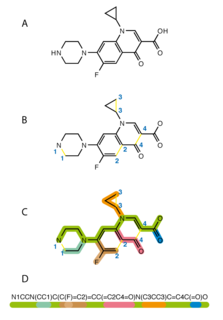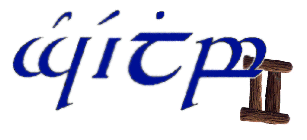Prolog is a logic programming language associated with artificial intelligence and computational linguistics.

The simplified molecular-input line-entry system (SMILES) is a specification in the form of a line notation for describing the structure of chemical species using short ASCII strings. SMILES strings can be imported by most molecule editors for conversion back into two-dimensional drawings or three-dimensional models of the molecules.
The Object Constraint Language (OCL) is a declarative language describing rules applying to Unified Modeling Language (UML) models developed at IBM and is now part of the UML standard. Initially, OCL was merely a formal specification language extension for UML. OCL may now be used with any Meta-Object Facility (MOF) Object Management Group (OMG) meta-model, including UML. The Object Constraint Language is a precise text language that provides constraint and object query expressions on any MOF model or meta-model that cannot otherwise be expressed by diagrammatic notation. OCL is a key component of the new OMG standard recommendation for transforming models, the Queries/Views/Transformations (QVT) specification.
In software engineering, profiling is a form of dynamic program analysis that measures, for example, the space (memory) or time complexity of a program, the usage of particular instructions, or the frequency and duration of function calls. Most commonly, profiling information serves to aid program optimization.
A Markov logic network (MLN) is a probabilistic logic which applies the ideas of a Markov network to first-order logic, enabling uncertain inference. Markov logic networks generalize first-order logic, in the sense that, in a certain limit, all unsatisfiable statements have a probability of zero, and all tautologies have probability one.

JOELib is computer software, a chemical expert system used mainly to interconvert chemical file formats. Because of its strong relationship to informatics, this program belongs more to the category cheminformatics than to molecular modelling. It is available for Windows, Unix and other operating systems supporting the programming language Java. It is free and open-source software distributed under the GNU General Public License (GPL) 2.0.
Oracle Spatial and Graph, formerly Oracle Spatial, forms a separately-licensed option component of the Oracle Database. The spatial features in Oracle Spatial and Graph aid users in managing geographic and location-data in a native type within an Oracle database, potentially supporting a wide range of applications — from automated mapping, facilities management, and geographic information systems (AM/FM/GIS), to wireless location services and location-enabled e-business. The graph features in Oracle Spatial and Graph include Oracle Network Data Model (NDM) graphs used in traditional network applications in major transportation, telcos, utilities and energy organizations and RDF semantic graphs used in social networks and social interactions and in linking disparate data sets to address requirements from the research, health sciences, finance, media and intelligence communities.
The SYBYL line notation or SLN is a specification for unambiguously describing the structure of chemical molecules using short ASCII strings. SLN differs from SMILES in several significant ways. SLN can specify molecules, molecular queries, and reactions in a single line notation whereas SMILES handles these through language extensions. SLN has support for relative stereochemistry, it can distinguish mixtures of enantiomers from pure molecules with pure but unresolved stereochemistry. In SMILES aromaticity is considered to be a property of both atoms and bonds whereas in SLN it is a property of bonds.

Eclipse RDF4J is an open-source framework for querying and analyzing RDF data. It was created by the Dutch software company Aduna as part of "On-To-Knowledge", a semantic web project that ran from 1999 to 2002. It contains implementations of an in-memory triplestore and an on-disk triplestore, along with two separate Servlet packages that can be used to manage and provide access to these triplestores, on a permanent server. The Sesame Rio package contains a simple API for Java-based RDF parsers and writers. Parsers and writers for popular RDF serialisations are distributed along with Sesame, and users can easily extend the list by putting their parsers and writers on the Java classpath when running their application.
In the fields of chemical graph theory, molecular topology, and mathematical chemistry, a topological index also known as a connectivity index is a type of a molecular descriptor that is calculated based on the molecular graph of a chemical compound. Topological indices are numerical parameters of a graph which characterize its topology and are usually graph invariant. Topological indices are used for example in the development of quantitative structure-activity relationships (QSARs) in which the biological activity or other properties of molecules are correlated with their chemical structure.
SMILES arbitrary target specification (SMARTS) is a language for specifying substructural patterns in molecules. The SMARTS line notation is expressive and allows extremely precise and transparent substructural specification and atom typing.

OpenCog is a project that aims to build an open source artificial intelligence framework. OpenCog Prime is an architecture for robot and virtual embodied cognition that defines a set of interacting components designed to give rise to human-equivalent artificial general intelligence (AGI) as an emergent phenomenon of the whole system. OpenCog Prime's design is primarily the work of Ben Goertzel while the OpenCog framework is intended as a generic framework for broad-based AGI research. Research utilizing OpenCog has been published in journals and presented at conferences and workshops including the annual Conference on Artificial General Intelligence. OpenCog is released under the terms of the GNU Affero General Public License.

Sones GraphDB was a graph database developed by the German company sones GmbH, available from 2010 to 2012. Its last version was released in May 2011. sones GmbH, which was based in Erfurt and Leipzig, was declared bankrupt on January 1, 2012.
GeoSPARQL is a standard for representation and querying of geospatial linked data for the Semantic Web from the Open Geospatial Consortium (OGC). The definition of a small ontology based on well-understood OGC standards is intended to provide a standardized exchange basis for geospatial RDF data which can support both qualitative and quantitative spatial reasoning and querying with the SPARQL database query language.
ArangoDB is a native multi-model database system developed by ArangoDB GmbH. The database system supports three data models with one database core and a unified query language AQL. The query language is declarative and allows the combination of different data access patterns in a single query. ArangoDB is a NoSQL database system but AQL is similar in many ways to SQL.

GraphQL is an open-source data query and manipulation language for APIs, and a runtime for fulfilling queries with existing data. GraphQL was developed internally by Facebook in 2012 before being publicly released in 2015. On 7 November 2018, the GraphQL project was moved from Facebook to the newly-established GraphQL Foundation, hosted by the non-profit Linux Foundation.
This is a list of articles related to the JavaScript programming language.






